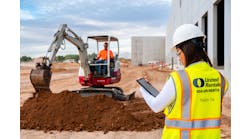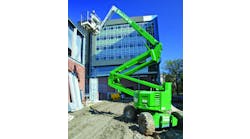Most engine makers and equipment manufacturers are making significant changes to their machines in preparation for Interim and Final Tier-4 regulations, which will begin going into effect in 2011. Here is a brief look at innovations from some manufacturers:
Case Construction Equipment: Case has developed a solution that relies on two technologies: cooled exhaust gas recirculation (EGR) and selective catalytic reduction (SCR). Case makes many of its own engines with various engine partners, particularly Fiat Powertrain Technologies. The company works to integrate engine solutions into machine construction.
Caterpillar: Embarking on the most significant product introduction program in company history, Caterpillar is using simulation tools and virtual assembly, and expects improvements in engine fuel consumption of up to 5 percent depending on application and load factors.
Cummins: Designed Cummins compact catalyst in response to need to accommodate additional engine architecture and after-treatment. No change to user interface, DPF re-generation accomplished with a flow-through device that does it all on its own. OEMs will not have to make major changes to install Cummins solution. Will maintain a single turbocharger with improved performance; Cummins compact catalyst can replace today's muffler with the same noise attenuation.
Cummins Tier-4 engines will also incorporate a coalescing crankcase filter to meet EPA regulations that require the elimination of crankcase emissions. A simple replacement element change is required at 2,500 hour intervals for the filter. Overall operating costs for Tier-4 products will be significantly reduced with fuel efficiency improvements of up to 5 percent, dependent on rating and duty cycle.
Deere: John Deere Power Systems' PowerTech Plus engine platform includes EGR for NOx control with the addition of an exhaust filter for reducing particulates. Its PowerTech M and PowerTech E 2.4-L engines below 56 kW (75 hp) meet Interim Tier-4 regulations without the addition of an exhaust filter. Technologies such as cooled EGR, VGT, and exhaust filters will likely be the foundation for meeting Final Tier-4/Stage IV regulations.
Fuel-injection pressures have increased and the cooled EGR system has added precision by operating the system in a “closed loop” control mode. Another building block is the addition of the exhaust filter, which is comprised of a diesel oxidation catalyst (DOC) and a diesel particulate filter (DPF).
All IT4 engines will include the “JD Link” system that will enable rental company technicians to remotely monitor engine conditions and status, as well as perform engine diagnostics. Thus, if there is a need for service, the technicians will be able to assemble the correct parts and tools needed prior to leaving their shop, eliminating the need for multiple trips to a jobsite.
Deutz: Modern common rail fuel injection system, rear gear drive and optional balancer shafts lower noise and vibration. Incorporates high-pressure common rail system and maintenance-free valve train. Modular DVERT system implements different emission-reducing techniques.
Ditch Witch: Incorporating custom-designed mufflers to fit products to accommodate after-treatment devices. Using hydraulically driven, computer-controlled variable-speed cooling fans to cool engines. Working to size exhaust fluid tanks to avoid having to be re-filled at every fuel fill.
Gehl: Working on creating necessary space for DPFs and SCRs, as well as developing additional gauges, warning lights as well as training and education on what is happening with emissions-control devices.
Kohler: Incorporates a combination of improvements to fuel injectors, controls in the combustion chamber, and exhaust after-treatment practices such as EGR. Has been an innovator with electronic fuel injection on its gas engines, and has applied the technology in the form of common rail system to diesel.
Komatsu: Has designed and developed new components such as variable geometry turbocharger; DPF; heavy-duty high-pressure common rail fuel-injection system; larger more robust cooled EGR system; closed crankcase ventilation system; high-efficiency combustion chamber at top of piston; harmonized engine and machine interface by computer control.
Komatsu manufacturing plants have added tooling and assembly lines to produce each of these components in-house. Has used expertise in hydraulics to design high-precision hydraulic actuators for the EGR valve and VGT.
Multiquip: The use of electronically controlled engines allows Multiquip to provide customers with newly available monitoring and operational controls.
Snorkel: Changes in Tier-4 engines will lead to possible redesigns of cowling, both to handle the extra space required by after-treatments, and to accommodate extreme temperatures. Possibly exploring more alternative power methods, including electric drives.
Terex Aerial: Including electronic engine control, a diesel particulate filter, an EGR system and a larger radiator to handle the higher heat rejection. Products with tight engine compartments may require new engine covers and other changes to accommodate the DPF and larger radiator. Large telehandlers, in Tier-4 final standards, will feature SCR, which requires Urea injection into the exhaust stream.
Volvo: One of the world's largest manufacturers of diesel engines for both on-road and off-road use, Volvo is using cooled EGR in combination with variable geometry turbo-type turbocharger, and an electronically controlled EGR valve that manages the desired mix of re-circulated exhaust gas and incoming fresh air in each instance of engine operation. The VGT features a sliding nozzle that allows the speed of exhaust flow into the turbine wheel to vary so as to provide rapid and powerful boost and torque and engine response across the entire engine speed range. The engine's electronic control unit controls the action of the entire system.
Accuracy of metering the re-circulated gas and the inlet air is crucial to achieving full control of NOx and PM emissions while maintaining required engine performance and fuel economy. Volvo will use an exhaust after-treatment system, which consists of a DPF of the active type, containing a catalytic, coated ceramic design and a burner for regeneration of the filter. The catalytic coating contributes towards reducing HC and CO emissions below limit values. The entire exhaust after-treatment is integrated into the engine system.





